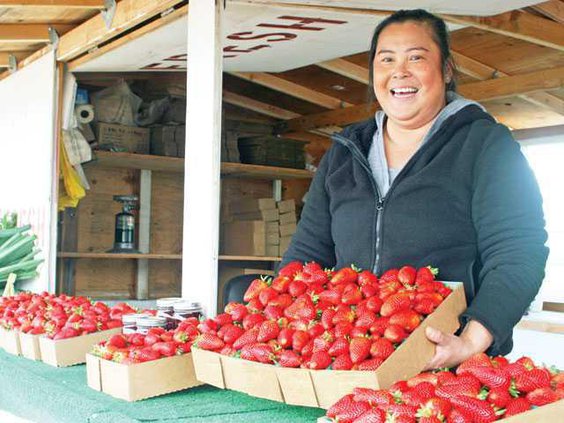Early morning before the sun peeks over the rim of the eastern horizon finds husband and wife Sai Saelee and Fahm Saechao at their small farm plot on West Yosemite Avenue.
That dawn-to-dusk ritual will be repeated through the end of summer.
It’s strawberry-harvest time.
Just a holler away to the east of the strawberry field, on the corner of McKinley and Yosemite avenues, is the couple’s countryside fruit stand where passersbys can purchase the literally farm-fresh juicy and sweet-smelling fruit by the basket. Each one has been painstakingly and carefully plucked by hand straight from the ground-hugging plants that have been nurtured personally by Saelee and Saechao since November when the couple, who immigrated to America from Cambodia, planted with their bare hands the bare-root strawberries on vein-like rows of plastic-covered dirt mounds.
“We’ll be here until we run out (of strawberries), until the season is over,” said a smiling Saechao on the first day they opened their fruit stand last week.
This time, the couple planted Albion, one of the dozen or so strawberry varieties for California.
“Some people like this because they’re crunchy,” she said of the longer and larger variety than the Chandler that they have cultivated in previous years.
The Chandler is smaller than the Albion but “it’s juicy,” Saechao said. This smaller variety was favored by her uncle and aunt, Luang and Yen Lee Saelee, with whom they co-farmed the larger strawberry fields on the southwest corner of West Yosemite and McKinley avenues years ago before the Saelees retired. That corner field became unavailable because it is being readied for a new development. The property is part of the South Lathrop Specific Plan that may get started at any time.
Strawberries mean $3.4 billion infusion to California’s economy
Saelee and Saechao’s roughly five-acre leased plot is one of 400 small family-owned strawberry farms in California, according to the California Strawberry Commission.
In a recent AgAlert magazine article, Commission president Rick Tomlinson is quoted as saying the 400 family farms “are the foundation for on-farm jobs, as well as packaging, shipping, processing, marketing, nutrition, science and export jobs that create opportunity.”
He added that California not only has “the best climate on earth to grow strawberries, it also has the most innovative and hard-working strawberry farmers in the world.”
The AgAlert story also points out the real value of the strawberry crop to California. According to a new report from the California Strawberry Commission, strawberry farming contributes $3.4 billion to the Golden State’s economy.
Other highlights from the same report:
• California leads US and the world in strawberry production.
• California grows nearly 90 percent of US strawberries.
• If California were a country, it would be the world’s largest producer of strawberries.
• Strawberry farming creates jobs and generates revenue beyond the farm.
• 400 family-owned strawberry farms in California.
• Strawberry farms generate an estimated 70,000 farm jobs while growing strawberries on fewer than 40,000 acres, less than 1 percent of all California farmland.
• Strawberry farming accounts for an estimated $108 million in annual tax revenue which supports local, state and regional government services, not to mention the support taxes provide to police and fire services.
Another unique aspect of strawberry farming in the Golden State is that the plant’s entire life cycle takes place in California. It begins with the roughly 1 billion plants that are raised in Northern California, including those grown in and around Manteca, from October to February which are then shipped to various regions for growing.





